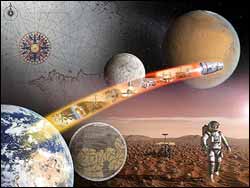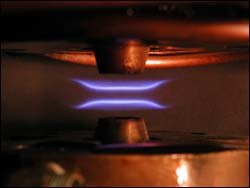This area deals with the fundamental laws and building blocks of nature and how they interact, the properties and the behavior of matter, and research into space and time and their structures.
innovations-report provides in-depth reports and articles on subjects such as astrophysics, laser technologies, nuclear, quantum, particle and solid-state physics, nanotechnologies, planetary research and findings (Mars, Venus) and developments related to the Hubble Telescope.

Using ESA’s Integral and XMM-Newton observatories, an international team of astronomers has found more evidence that massive black holes are surrounded by a doughnut-shaped gas cloud, called a torus. Depending on our line of sight, the torus can block the view of the black hole in the centre. The team looked `edge on’ into this doughnut to see features never before revealed in such a clarity.
Black holes are objects so compact and with gravity so strong that not even light can escape from

By depositing thin films of silicon nanoparticles on silicon substrates, researchers at the University of Illinois at Urbana-Champaign have fabricated a photodetector sensitive to ultraviolet light. Silicon-based ultraviolet sensors could prove very handy in military, security and commercial applications.
“Silicon is the most common semiconductor, but it has not been useful for detecting ultraviolet light until now,” said Munir Nayfeh, a professor of physics at Illinois and a researcher at t

A major breakthrough in pinpointing some of the most primordial and violently star forming galaxies in the Universe has been made by a joint collaboration of UK and US astronomers using the Spitzer Space Telescope to resolve primordial galaxies initially detected by the James Clerk Maxwell telescope [JCMT]. UK astronomers from the University of Kent, The Royal Observatory Edinburgh and the University of Oxford teamed up with American cosmologists to finally identify these elusive galaxies. The work w

At the last meeting of the Aurora Board of Participants, held at ESA’s Paris headquarters on Thursday 8 July, the participating states approved the Preparatory Phase of the European Space Exploration Programme (ESEP).
Revising the original Declaration, the European countries already participating, plus Canada, unanimously agreed to remodel Aurora into a broader preparatory ESEP. This is with a view to possibly increasing their subscriptions and welcoming further participants, including

Like virtuosos tuning their violins, researchers at the University of Illinois at Urbana-Champaign have tuned their instruments and harmonized the production of entangled photons, pushing rates to more than 1 million pairs per second.
The brighter and purer entangled states could assist researchers in applications involving quantum information processing – such as quantum computation, teleportation and cryptography – and help scientists better understand the mysterious transition from quan

Tiny pellets of fuel may be safer for hazardous places on earth and burn more efficiently in weightless space and low-gravity environments
Researchers from the USC Viterbi School of Engineering say solid fuel particles may be safer for hazardous environments on earth and burn more efficiently in the microgravity of space than gaseous fuels, which are more combustible and difficult to transport.
In the Spring 2004 issue of NASA Space Research, Fokion Egolfopoulos and Charles